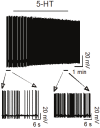Serotonergic modulation of Neural activities in the entorhinal cortex
- PMID: 23320133
- PMCID: PMC3544218
Serotonergic modulation of Neural activities in the entorhinal cortex
Abstract
The entorhinal cortex (EC) is considered as the gate to control the flow of information into and out of the hippocampus. The EC is important for numerous physiological functions such as emotional control, learning and memory and pathological disorders including Alzheimer's disease, schizophrenia and temporal lobe epilepsy. Serotonin is a classical neurotransmitter which may modify these physiological functions and pathology of neurological diseases. The EC receives profuse serotonergic innervations from the raphe nuclei in the brainstem and expresses high density of serotonergic receptors including 5-HT(1A), 5-HT(1D), 5-HT(1E), 5-HT(2A), 5-HT(3) and 5-HT(6). The prominent innervation by serotonergic neurons and the dense expression of serotonergic receptors in the EC suggest that serotonin is a major modulator in this brain region. Serotonin exerts inhibitory effects in the EC. Serotonin hyperpolarizes entorhinal neurons and inhibits the excitatory synaptic transmission via activation of 5-HT(1A) receptors but facilitates GABA release via activation of 5-HT(2A) receptors. Both 5-HT(1A) and 5-HT(2A) receptors are required for serotonin-induced inhibition of epileptiform activity although 5-HT(3) receptors may be involved in serotonin-mediated inhibition of acetylcholine release in the EC. Furthermore, the functions of serotonin in the EC may be implicated in Parkinson's disease, Alzheimer's disease and depression. Thus, understanding the roles of serotonergic modulation in the EC is of major clinical importance. Here, I review recent findings concerning the effects of serotonin on neural circuitry activity in the EC.
Keywords: G-protein coupled receptor; GABA; Glutamate; epilepsy; neurotransmitter; synaptic transmission.
Figures
Similar articles
-
Fenfluramine blocks low-Mg2+-induced epileptiform activity in rat entorhinal cortex.Epilepsia. 2000 Aug;41(8):925-8. doi: 10.1111/j.1528-1157.2000.tb00273.x. Epilepsia. 2000. PMID: 10961615
-
The pharmacology of the neurochemical transmission in the midbrain raphe nuclei of the rat.Curr Neuropharmacol. 2006 Oct;4(4):313-39. doi: 10.2174/157015906778520764. Curr Neuropharmacol. 2006. PMID: 18654635 Free PMC article.
-
Serotonin modulation of hippocampal functions: From anatomy to neurotherapeutics.Prog Brain Res. 2021;261:83-158. doi: 10.1016/bs.pbr.2021.01.031. Epub 2021 Mar 10. Prog Brain Res. 2021. PMID: 33785139 Review.
-
Comparison of the effects of serotonin in the hippocampus and the entorhinal cortex.Mol Neurobiol. 1998 Winter;17(1-3):59-72. doi: 10.1007/BF02802024. Mol Neurobiol. 1998. PMID: 9887446 Review.
-
[Serotonergic control of prefrontal cortex].Rev Neurol. 2004 Sep 16-30;39(6):539-47. Rev Neurol. 2004. PMID: 15467993 Review. Spanish.
Cited by
-
Electroacupuncture stimulation of auricular concha region improves loss of control over stress induced depression-like behavior by modulating 5-hydroxytryptamine 1A receptor.J Tradit Chin Med. 2025 Apr;45(2):326-334. doi: 10.19852/j.cnki.jtcm.2025.02.014. J Tradit Chin Med. 2025. PMID: 40151119 Free PMC article.
-
Neurotransmission Sex Dichotomy in the Rat Hypothalamic Paraventricular Nucleus in Healthy and Infantile Spasm Model.Curr Issues Mol Biol. 2025 May 21;47(5):380. doi: 10.3390/cimb47050380. Curr Issues Mol Biol. 2025. PMID: 40699779 Free PMC article.
-
Neuropathology of the Brainstem to Mechanistically Understand and to Treat Alzheimer's Disease.J Clin Med. 2021 Apr 7;10(8):1555. doi: 10.3390/jcm10081555. J Clin Med. 2021. PMID: 33917176 Free PMC article. Review.
-
Monoaminergic neuropathology in Alzheimer's disease.Prog Neurobiol. 2017 Apr;151:101-138. doi: 10.1016/j.pneurobio.2016.04.001. Epub 2016 Apr 12. Prog Neurobiol. 2017. PMID: 27084356 Free PMC article. Review.
-
Effect of ramosetron, a 5-HT3 receptor antagonist on the severity of seizures and memory impairment in electrical amygdala kindled rats.J Physiol Sci. 2022 Jan 16;72(1):1. doi: 10.1186/s12576-022-00825-5. J Physiol Sci. 2022. PMID: 35034601 Free PMC article.
References
-
- Witter MP, Groenewegen HJ, Lopes da Silva FH, Lohman AH. Functional organization of the extrinsic and intrinsic circuitry of the parahippocampal region. Prog Neurobiol. 1989;33:161–253. - PubMed
-
- Witter MP, Naber PA, van Haeften T, Machielsen WC, Rombouts SA, Barkhof F, Scheltens P, Lopes da Silva FH. Cortico-hippocampal communication by way of parallel parahippocampal-subicular pathways. Hippocampus. 2000;10:398–410. - PubMed
-
- Burwell RD. The parahippocampal region: corticocortical connectivity. Ann N Y Acad Sci. 2000;911:25–42. - PubMed
-
- Steward O, Scoville SA. Cells of origin of entorhinal cortical afferents to the hippocampus and fascia dentata of the rat. J Comp Neurol. 1976;169:347–370. - PubMed
-
- Witter MP, Wouterlood FG, Naber PA, Van Haeften T. Anatomical organization of the parahippocampal-hippocampal network. Ann N Y Acad Sci. 2000;911:1–24. - PubMed
Grants and funding
LinkOut - more resources
Full Text Sources


